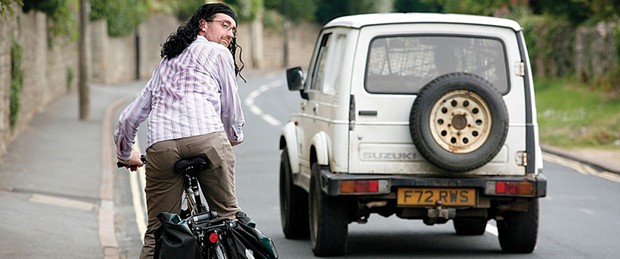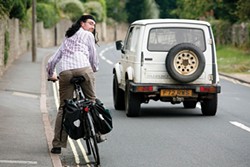[
{
"name": "Top Stories Video Pair",
"insertPoint": "7",
"component": "17087298",
"parentWrapperClass": "fdn-ads-inline-content-block",
"requiredCountToDisplay": "1"
}
]
Hey Barry, where's your helmet?" called out the city council member as I cycled past her on Seventh Street this morning. She's certainly in tune with conventional wisdom, which holds that biking without a helmet is dumb, like driving without a seatbelt. Truth is, I rarely wear my helmet around town during daylight hours, while I do on country roads, off-road and at night. Meanwhile, I believe kids, who are frequently involved in spills, should always wear them. This being National Bike Month, and with bike helmets in the news (State Senator Carol Liu recently put her proposed mandatory helmet law on hold after a backlash from organized bicycling advocates) this seems a good time to review helmet use.
A 2013 Canadian study using data from hospital admissions concluded that the effect of Canada's mandatory helmet laws "seems to have been minimal."
A study of four urban areas (Washington, DC, Minneapolis, New York and Montreal) found that total bike-related injuries dropped by 28 percent (head injuries by 14 percent) after the introduction of city bike-share systems, in which very few riders wear helmets. Researchers speculate that the reductions result from better bike infrastructure and the "safety in numbers" effect.
A 2006 meta-study on the effect of mandatory helmet use in New Zealand and Australia found that "enforced helmet laws discourage cycling but produce no obvious response in percentage of head injuries."
This last finding is important: If helmet laws deter people from cycling, what does that do to overall health? Statistically, and taking the risks of non-helmet use into account, cycling extends life. For instance, a 2011 study of nearly 200,000 users of the "Bicing" bike-share system in Barcelona (Spain) concluded that the program reduced the expected number of deaths from 52 to 40.
The "safety in numbers" argument claims that the more bikes are on the road, the safer each individual cyclist is. For example, a 45 percent increase in bicycling from 1980 to 2005 in the Netherlands coincided with a 58 percent decrease in bike fatalities.
My larger concern with mandatory helmet laws is that they shift the responsibility for safety from the community to the individual cyclist, leading to less investment in bike-friendly infrastructure, such as bike lanes and traffic calming programs. In countries like the Netherlands and Denmark, where routine urban cycling goes hand-in-hand with low injury rates, cyclists enjoy far better infrastructure than in typical U.S. "car rules" cities. Incidentally, a 2011 study for Portland, Oregon estimated that every million dollars invested in bike infrastructure results in nearly three million dollars saved in health care.
Ten years ago, a well-publicized one-man experiment in Britain found that helmet use resulted in decreased vehicle-to-bike clearance. Using an ultrasonic "ruler," cyclist Ian Walker recorded some 2,500 clearance distances while being overtaken: Drivers gave him nearly 4 inches more space when he wasn't wearing a helmet than when he was. Interestingly, when he wore a long wig, he got an extra 10 inches of clearance! "We know helmets are useful in low-speed falls, and so are definitely good for children," he said. "But [for adults], wearing a helmet might make a collision more likely in the first place."
My take is this: On balance, an adult cyclist in a crash is better off wearing a helmet, but is less likely than a child to be involved in an accident in the first place. Meanwhile, cyclists — helmeted or not — live longer on average. One final kicker: Mile for mile, a pedestrian is 3.5 times more likely than a cyclist to die in a traffic accident.
Barry Evans ([email protected]) believes cycling is how God wants us to travel.
Comments
Showing 1-1 of 1
more from the author
-
A Brief History of Dildos
- Apr 11, 2024
-
Eclipse!
- Mar 28, 2024
-
The Little Drone that Could
- Mar 14, 2024
- More »
Latest in Field Notes
Readers also liked…
-
Trouble on the Line: The Reality Part 2
- Nov 3, 2022



































